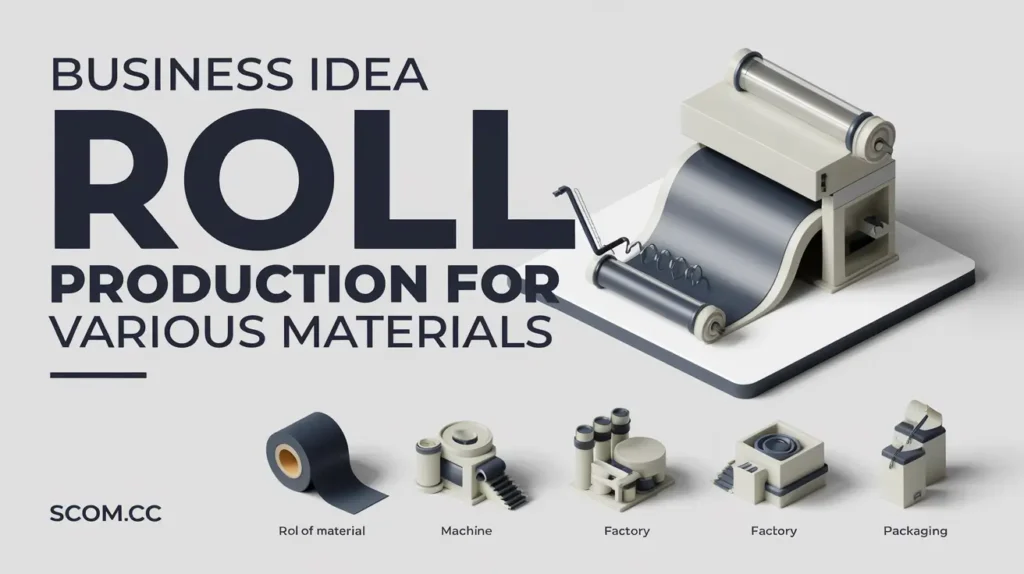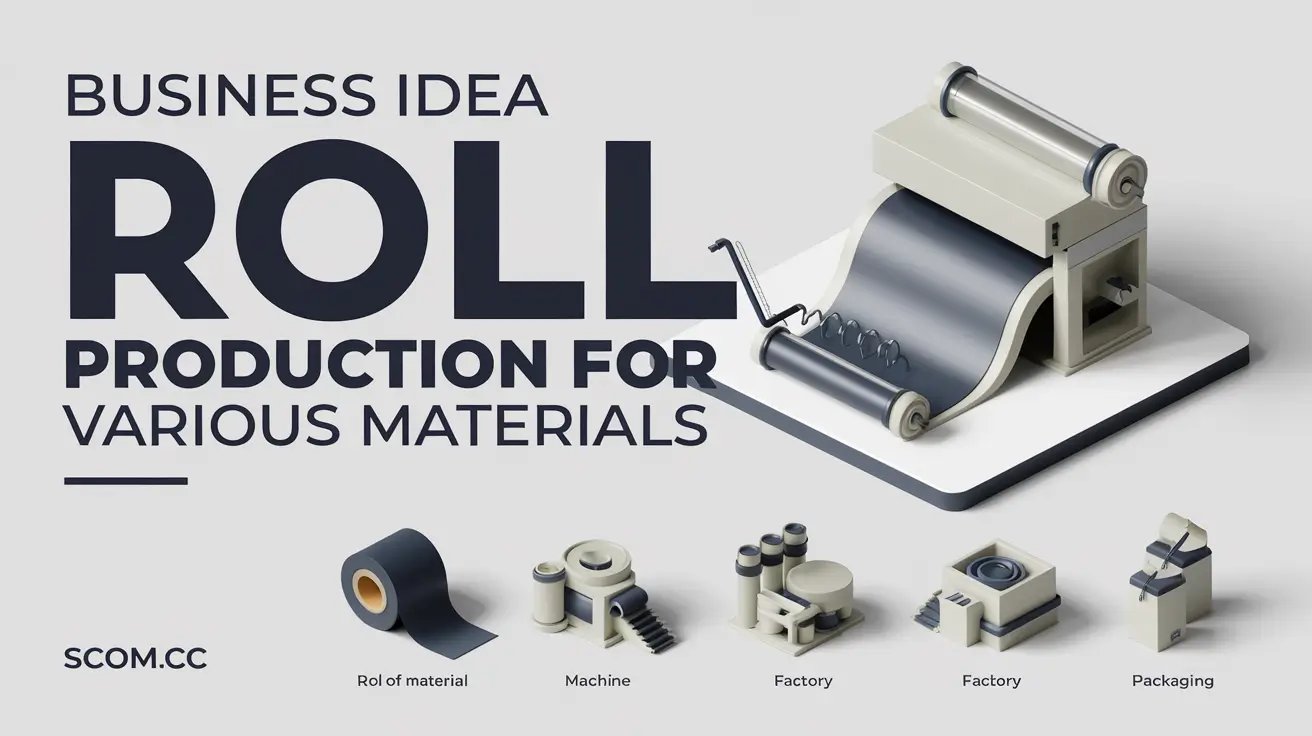Business Idea Roll Production for Various Materials

- Business Idea Roll Production for Various Materials
- What Is Roll Production?
- Market Potential for Roll Production
- Initial Costs and Investment
- Benefits of Roll Production
- Challenges and Considerations
- Legal and Regulatory Aspects
- Marketing and Placement Strategies
- Future Trends and Innovations
- Conclusion
- Summary Table: Business Idea Roll Production for Various Materials
-
FAQ: Business Idea Roll Production for Various Materials
- What is roll production?
- What are the initial costs for starting a roll production business?
- What are the main benefits of roll production?
- What challenges might businesses face in roll production?
- What legal and regulatory aspects should be considered?
- How can businesses effectively market their roll production services?
- What are the future trends in roll production?
Business Idea Roll Production for Various Materials
Roll Production for Various Materials: A Profitable Business Opportunity
Introduction to Roll Production
Start a production line for rolls of various materials, ideal for textile, plastic, and other rollable product manufacturers.
Roll production is a vital process in multiple industries, from textiles and plastics to packaging and construction materials. Offering a production line for rolls of various materials allows businesses to cater to manufacturers who require high-quality, consistent rolls for their products. This guide explores the concept of roll production, its market potential, the benefits of starting such a business, and the key considerations for success.
What Is Roll Production?
Roll production involves the manufacturing of materials in roll form, which can be used in a wide range of industries. These rolls can be made from different materials, including textiles, plastics, paper, and metals, depending on the needs of the market.
Common Types of Rolls
- Textile Rolls: Fabrics, non-woven materials, and other textiles used in clothing, upholstery, and industrial applications.
- Plastic Rolls: Polyethylene, PVC, and other plastic materials for packaging, construction, and manufacturing.
- Paper Rolls: Rolls of paper used in printing, packaging, and other applications.
- Metal Rolls: Thin sheets of metal rolled for use in construction, automotive, and industrial sectors.
Market Potential for Roll Production
The demand for roll production is significant across various industries, as rolls offer a convenient and efficient way to handle and transport materials. With industries constantly evolving and expanding, there is a growing need for specialized roll production services.
Target Markets
- Textile Manufacturers: Companies producing fabrics and other textile materials for clothing, home furnishings, and industrial use.
- Plastic and Packaging Industry: Businesses requiring plastic rolls for packaging, wrapping, and construction applications.
- Printing and Paper Industry: Companies producing paper rolls for printing, packaging, and office supplies.
- Construction and Industrial Sectors: Industries that use metal rolls for various construction and manufacturing purposes.
Initial Costs and Investment
Starting a roll production business involves significant initial costs, primarily for purchasing machinery, securing raw materials, and setting up the production line. Proper financial planning and budgeting are essential to ensure a smooth launch.
Cost Breakdown
- Machinery: Roll-forming machines can range from $100,000 to $500,000, depending on the material and production capacity.
- Raw Materials: Costs for acquiring materials such as textiles, plastics, paper, or metal sheets, which vary based on quality and quantity.
- Facility Setup: Expenses for setting up the production facility, including space, utilities, and installation of equipment.
- Labor and Training: Costs associated with hiring skilled labor and providing training for operating machinery.
Benefits of Roll Production
Roll production offers numerous advantages, particularly in terms of scalability, versatility, and the ability to serve various industries. These benefits make it an attractive business opportunity.
Advantages
- High Demand: Consistent need for rolls in multiple industries ensures a steady stream of potential clients.
- Versatility: Ability to produce rolls from a variety of materials, catering to different market segments.
- Scalability: Opportunity to expand production capacity and introduce new materials as demand grows.
- Efficiency: Roll production offers a cost-effective and efficient method for producing large quantities of material.
Challenges and Considerations
While roll production presents significant opportunities, there are challenges that businesses must address to ensure success. Strategic planning and effective management are key to overcoming these obstacles.
Common Challenges
- High Initial Investment: Significant capital required for machinery and facility setup.
- Material Costs: Fluctuations in the cost of raw materials can impact profitability.
- Market Competition: Competition from other roll producers and material manufacturers.
- Quality Control: Ensuring consistent quality across different types of rolls and materials.
Legal and Regulatory Aspects
Operating a roll production business involves adhering to various legal and regulatory requirements. Compliance is crucial for maintaining product quality, safety, and environmental responsibility.
Key Regulations
- Quality Standards: Adherence to industry standards for material quality, thickness, and durability.
- Safety Regulations: Compliance with workplace safety regulations, including machinery operation and employee safety.
- Environmental Regulations: Ensuring that production processes are eco-friendly and comply with waste management and emissions regulations.
- Licensing and Permits: Obtaining necessary licenses and permits for manufacturing operations.
Marketing and Placement Strategies
Effective marketing and placement strategies are essential for promoting roll production services and reaching potential clients. Building a strong market presence can enhance visibility and attract business.
Marketing Tips
- Highlight Capabilities: Showcase the range of materials and rolls offered, along with customization options.
- Target Specific Industries: Focus marketing efforts on textile manufacturers, packaging companies, and industrial sectors.
- Build a Strong Brand: Develop a professional brand image and online presence to attract clients.
- Leverage Industry Networks: Engage with industry associations and networks to build connections and gain referrals.
Future Trends and Innovations
The roll production industry is evolving with new trends and innovations. Staying informed about these developments can provide a competitive edge and help businesses adapt to changing market demands.
Emerging Trends
- Sustainable Materials: Increased demand for eco-friendly materials and sustainable production practices.
- Advanced Technology: Integration of automation, robotics, and digital tools for improved efficiency and precision.
- Customization and Personalisation: Growing interest in producing highly customized rolls for specific applications.
- Energy Efficiency: Adoption of energy-efficient technologies to reduce production costs and environmental impact.
Conclusion
Roll production for various materials offers a valuable opportunity to supply high-quality, consistent rolls to a wide range of industries. By understanding the market potential, managing initial costs, and addressing challenges, businesses can successfully establish and grow their roll production operations. With a focus on innovation, quality, and effective marketing, this business model can meet the increasing demand for rollable materials in the textile, plastic, packaging, and industrial sectors.
Summary Table: Business Idea Roll Production for Various Materials
| Aspect | Details |
|---|---|
| Service | Roll production for various materials |
| Key Features | Production of rolls from textiles, plastics, paper, and metals |
| Target Markets | Textile manufacturers, plastic and packaging industry, printing and paper industry, construction and industrial sectors |
| Initial Costs | $100,000 to $500,000 for machinery, plus raw materials, facility setup, and labor expenses |
| Benefits | High demand, versatility, scalability, efficiency |
| Challenges | High initial investment, material costs, market competition, quality control |
| Legal Requirements | Quality standards, safety regulations, environmental regulations, licensing and permits |
| Marketing Strategies | Highlight capabilities, target specific industries, build a strong brand, leverage industry networks |
| Future Trends | Sustainable materials, advanced technology, customization and personalisation, energy efficiency |
FAQ: Business Idea Roll Production for Various Materials
What is roll production?
Roll production involves manufacturing materials in roll form, which are used in various industries, including textiles, plastics, packaging, and construction.
What are the initial costs for starting a roll production business?
Initial costs include $100,000 to $500,000 for roll-forming machinery, plus expenses for raw materials, facility setup, installation, and labor.
What are the main benefits of roll production?
Benefits include high demand across multiple industries, versatility in material production, scalability, and cost-efficient manufacturing processes.
What challenges might businesses face in roll production?
Challenges include high initial investment, fluctuating material costs, competition in the market, and maintaining consistent quality.
What legal and regulatory aspects should be considered?
Businesses must comply with quality standards, safety regulations, environmental regulations, and obtain necessary licenses and permits.
How can businesses effectively market their roll production services?
Effective marketing strategies include showcasing production capabilities, targeting specific industries, building a strong brand, and leveraging industry networks.
What are the future trends in roll production?
Emerging trends include the use of sustainable materials, advanced technology integration, increased customization, and a focus on energy efficiency in production processes.

If you enjoyed this article and found it valuable, we encourage you to explore our news and valuable information section, where you'll find more relevant and up-to-date content that may pique your interest. Additionally, if you are seeking advice or need guidance on a specific topic, we suggest visiting our services section. There, you will find a variety of options designed to assist and support you in addressing your needs. Feel free to check out both sections to get the information and assistance that best suits your requirements.

Leave a Reply